SKP alleviates the ferroptosis in diabetic kidney disease through suppression of HIF-1α/HO-1 pathway based on network pharmacology analysis and experimental validation
- PMID: 38403669
- PMCID: PMC10894492
- DOI: 10.1186/s13020-024-00901-5
SKP alleviates the ferroptosis in diabetic kidney disease through suppression of HIF-1α/HO-1 pathway based on network pharmacology analysis and experimental validation
Abstract
Background: Diabetic kidney disease (DKD) represents a microvascular complication of diabetes mellitus. Shenkang Pills (SKP), a traditional Chinese medicine formula, has been widely used in the treatment of DKD and has obvious antioxidant effect. Ferroptosis, a novel mode of cell death due to iron overload, has been shown to be associated with DKD. Nevertheless, the precise effects and underlying mechanisms of SKP on ferroptosis in diabetic kidney disease remain unclear.
Methods: The active components of SKP were retrieved from the Traditional Chinese Medicine Systems Pharmacology (TCMSP) database. Protein-protein interaction (PPI) network and Herb-ingredient-targets gene network were constructed using Cytoscape. Gene Ontology (GO) and Kyoto Encyclopedia of Genes and Genomes (KEGG) pathway enrichment analyses were conducted utilizing the Metascape system database. Additionally, an in vivo model of DKD induced by Streptozotocin (STZ) was established to further investigate and validate the possible mechanisms underlying the effectiveness of SKP.
Results: We retrieved 56 compounds and identified 223 targets of SKP through the TCMSP database. Key targets were ascertained using PPI network analysis. By constructing a Herb-Ingredient-Targets gene network, we isolated the primary active components in SKP that potentially counteract ferroptosis in diabetic kidney disease. KEGG pathway enrichment analysis suggested that SKP has the potential to alleviate ferroptosis through HIF signaling pathway, thereby mitigating renal injury in DKD. In animal experiments, fasting blood glucose, 24 h urine protein, urea nitrogen and serum creatine were measured. The results showed that SKP could improve DKD. Results from animal experiments were also confirmed the efficacy of SKP in alleviating renal fibrosis, oxidative stress and ferroptosis in DKD mice. These effects were accompanied by the significant reductions in renal tissue expression of HIF-1α and HO-1 proteins. The mRNA and immunohistochemistry results were the same as above.
Conclusions: SKP potentially mitigating renal injury in DKD by subduing ferroptosis through the intricacies of the HIF-1α/HO-1 signaling pathway.
Keywords: Diabetic kidney disease (DKD); Ferroptosis; HIF-1α/HO-1 signaling pathway; Network pharmacology; Shenkang pills (SKP).
© 2024. The Author(s).
Conflict of interest statement
The authors declare that they have no known competing commercial or financial relationships that could influence the work reported in this article.
Figures
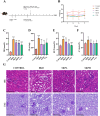
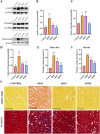

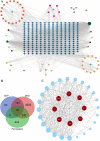
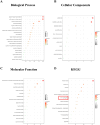

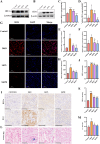

Similar articles
-
Molecular mechanisms of Potentilla Discolor Bunge in regulating ferroptosis to alleviate DKD via the Nrf2 signaling pathway.J Ethnopharmacol. 2025 Jun 26;350:120035. doi: 10.1016/j.jep.2025.120035. Epub 2025 May 23. J Ethnopharmacol. 2025. PMID: 40414576
-
Network pharmacology-based study on the mechanism of ShenKang injection in diabetic kidney disease through Keap1/Nrf2/Ho-1 signaling pathway.Phytomedicine. 2023 Sep;118:154915. doi: 10.1016/j.phymed.2023.154915. Epub 2023 Jun 10. Phytomedicine. 2023. PMID: 37392674
-
Mechanism of Tripterygium wilfordii Hook.F.- Trichosanthes kirilowii Maxim decoction in treatment of diabetic kidney disease based on network pharmacology and molecular docking.Front Pharmacol. 2022 Oct 28;13:940773. doi: 10.3389/fphar.2022.940773. eCollection 2022. Front Pharmacol. 2022. PMID: 36386135 Free PMC article.
-
Exploration of the mechanism of Zisheng Shenqi decoction against gout arthritis using network pharmacology.Comput Biol Chem. 2021 Feb;90:107358. doi: 10.1016/j.compbiolchem.2020.107358. Epub 2020 Aug 8. Comput Biol Chem. 2021. PMID: 33243703 Review.
-
Iron Metabolism and Ferroptosis in Diabetic Kidney Disease.Cell Biochem Funct. 2025 Apr;43(4):e70067. doi: 10.1002/cbf.70067. Cell Biochem Funct. 2025. PMID: 40166850 Review.
Cited by
-
Modulation of renal fibrosis-related signaling pathways by traditional Chinese medicine: molecular mechanisms and experimental evidence.Int Urol Nephrol. 2025 Apr 28. doi: 10.1007/s11255-025-04532-z. Online ahead of print. Int Urol Nephrol. 2025. PMID: 40293615 Review.
-
Comparative Analysis of Volatile Components in Chi-Nan and Ordinary Agarwood Aromatherapies: Implications for Sleep Improvement.Pharmaceuticals (Basel). 2024 Sep 11;17(9):1196. doi: 10.3390/ph17091196. Pharmaceuticals (Basel). 2024. PMID: 39338358 Free PMC article.
-
Metal-Dependent Cell Death in Renal Fibrosis: Now and in the Future.Int J Mol Sci. 2024 Dec 11;25(24):13279. doi: 10.3390/ijms252413279. Int J Mol Sci. 2024. PMID: 39769044 Free PMC article. Review.
-
Effective protective mechanisms of HO-1 in diabetic complications: a narrative review.Cell Death Discov. 2024 Oct 10;10(1):433. doi: 10.1038/s41420-024-02205-x. Cell Death Discov. 2024. PMID: 39389941 Free PMC article. Review.
-
Overexpression of GPX4 in diabetic rat kidney alleviates renal injury induced by ferroptosis.Biometals. 2025 Aug;38(4):1281-1297. doi: 10.1007/s10534-025-00706-5. Epub 2025 Jul 6. Biometals. 2025. PMID: 40618318
References
-
- Oshima M, Shimizu M, Yamanouchi M, Toyama T, Hara A, Furuichi K, et al. Trajectories of kidney function in diabetes: a clinicopathological update. Nat Rev Nephrol. 2021;17(11):740–750. - PubMed
-
- Tervaert TW, Mooyaart AL, Amann K, Cohen AH, Cook HT, Drachenberg CB, et al. Pathologic classification of diabetic nephropathy. J Am Soc Nephrol. 2010;21(4):556–563. - PubMed
-
- Hu Q, Chen Y, Deng X, Li Y, Ma X, Zeng J, et al. Diabetic nephropathy: focusing on pathological signals, clinical treatment, and dietary regulation. Biomed Pharmacothera. 2023;159:114252. - PubMed
-
- Lytvyn Y, Godoy LC, Scholtes RA, van Raalte DH, Cherney DZ. Mineralocorticoid antagonism and diabetic kidney disease. Curr Diabetes Rep. 2019;19(1):4. - PubMed
Grants and funding
LinkOut - more resources
Full Text Sources

